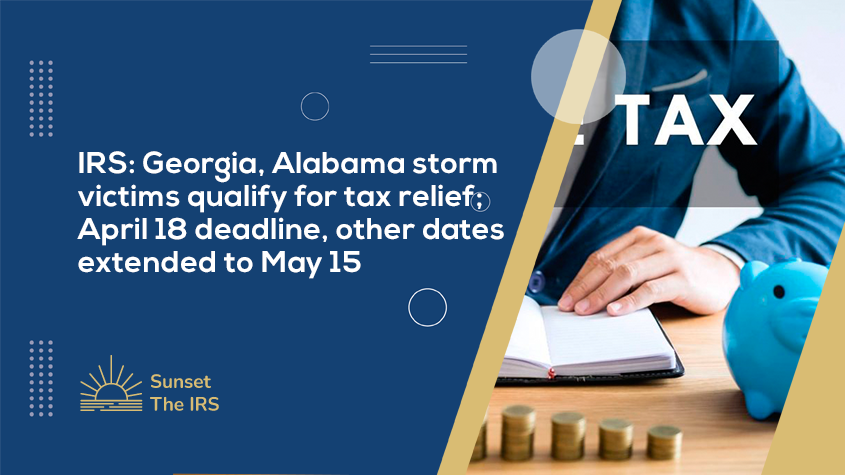IRS: Georgia, Alabama storm victims qualify for tax relief; April 18 deadline, other dates extended to May 15

Gustavo Lopez
Writer

Victims of the storm in parts of Georgia and Alabama now have until May 15, 2023 to file various individual and corporate federal tax returns and make tax payments, the Internal Revenue Service announced today.
The IRS provides relief to any area designated by the Federal Emergency Management Agency (FEMA) . This means that individuals and families who reside or have businesses in Butts, Henry, Jasper, Meriwether, Newton, Spalding and Troup counties in Georgia and Autauga and Dallas counties in Alabama are eligible for tax relief. Other areas that are later added to the disaster area will also qualify for the same rescue. The current list of eligible locations can be found at Tax Relief in Disaster Situations .
The tax relief postpones various tax filing and payment deadlines that occur on or after January 12, 2023. As a result, affected individuals and businesses will have until May 15, 2023 to file returns and pay taxes originally due on this period.
This includes 2022 personal income tax returns that are due on April 18, as well as various 2022 corporate returns that are normally due on March 15 and April 18. health savings accounts.
Additionally, farmers who choose to waive estimated tax payments and normally file their returns by March 1 will have until May 15, 2023 to file their 2022 return and pay any taxes owed. The May 15, 2023 deadline also applies to quarterly estimated tax payments, which are normally due on January 17, 2023 and April 18, 2023. This means individual taxpayers can skip paying estimated tax of the fourth quarter, normally due on January 17, 2023, and include it instead, with the 2022 return that they present, before May 15.
The May 15 deadline also applies to quarterly payroll and excise tax returns that are normally due on January 31 and April 30, 2023. In addition, penalties on payroll and excise tax payments due on or before January 12, 2023, will be reduced as long as tax payments are made before January 27, 2023.
The Disaster Relief and Emergency Relief for Individuals and Businesses page contains details about other tax-related filings, payments, and actions that qualify for the extra time.
The IRS automatically provides tax refunds and relief to any taxpayer with an IRS-registered address located in the disaster area. Therefore, taxpayers do not need to contact the agency to obtain this relief. However, if an affected taxpayer receives a late filing or late payment penalty notice from the IRS with an original or extended filing, payment, or filing due date that falls within the deferral period, the taxpayer should call the number provided. listed on the notice to get the penalty shot down.
In addition, the IRS will work with any taxpayer who lives outside of the disaster area but whose records needed to meet a deadline that occurs during the deferral period are located in the affected area. Eligible taxpayers living outside the disaster area should contact the IRS at 866-562-5227. This also includes workers helping relief efforts who are affiliated with a recognized philanthropic or government organization.
Individuals and businesses in a federally declared disaster area who have suffered uninsured or unpaid disaster-related losses may elect to claim them on the return for the year the loss occurred (in this case, the 2023 return). usually filed the following year) or prior year's return (2022, typically filed this tax season). Be sure to write the FEMA statement number (4684-DR for Alabama or 4685-DR for Georgia) on any statement claiming a loss. See publication 547 for more details.
The tax relief is part of a coordinated federal response to the damage caused by these storms and is based on local damage assessments conducted by FEMA. For information on disaster recovery, visit disasterassistance.gov.

